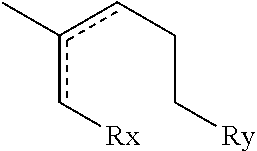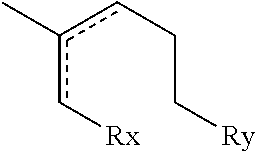Process to Produce Improved Poly Alpha Olefin Compositions
a technology of poly alpha olefin and composition, applied in the direction of lubricant composition, chemistry apparatus and processes, organic chemistry, etc., can solve the problems of low value compared to other portions of product stream, significant amount of dimer formation, and insufficient use of dimer as lubricant basestock, etc., to achieve high activity, improve process economics, and reduce the effect of oxidation
- Summary
- Abstract
- Description
- Claims
- Application Information
AI Technical Summary
Benefits of technology
Problems solved by technology
Method used
Image
Examples
example 1
[0122]A 97% pure 1-decene was fed to a stainless steel Parr reactor where it was sparged with nitrogen for 1 hour to obtain a purified feed. The purified stream of 1-decene was then fed at a rate of 2080 grams per hour to a stainless steel Parr reactor for oligomerization. The oligomerization temperature was 120° C. The catalyst was dimethylsilyl-bis(tetrahydroindenyl)zirconium dimethyl (hereinafter referred to as “Catalyst 1”). A catalyst solution including purified toluene, tri n-octyl aluminum (TNOA), and N,N-dimethylanilinium tetrakis(penta-fluorophenyl)borate (hereinafter referred to as “Activator 1”) was prepared per the following recipe based on 1 gram of Catalyst 1:
Catalyst 11gramPurified Toluene376grams25% TNOA in Toluene24gramsActivator 11.9grams
[0123]The 1-decene and catalyst solution were fed into the reactor at a ratio of 31,200 grams of LAO per gram of catalyst solution. Additional TNOA was also used as a scavenger to remove any polar impurities and added to the reacto...
example 2
[0124]The reactor effluent from Example 1 was distilled to remove the unreacted LAO and to separate the olefin fractions. The different olefin fractions were each hydrogenated in a stainless steel Parr reactor at 232° C. and 2413 kPa (350 psi) of hydrogen for 2 hours using 0.5 wt % Nickel Oxide catalyst. Properties of each hydrogenated distillation cut are shown in Table 4. This example demonstrates that, with the exception of the intermediate PAO dimer, the intermediate PAO cuts have excellent properties.
TABLE 4OligomerKV atKV atPourNoackYield100° C.40° C.PointVolatilityComponent(%)*(cSt)(cSt)VI(° C.)(%)Intermediate PAO Dimer (C20)331.794.98N / A−12N / AIntermediate PAO Trimer313.3913.5128−7512.53(C30)Intermediate PAO Tetramer+319.3453.57158−663.15(C40+)*Yields reported are equivalent to mass % of reactor effluent 6% of reactor effluent was monomer.
example 3
[0125]mPAO dimer portion from a reaction using the procedure of Example 1 (and therefor having the properties / components listed above), and prior to any hydrogenation of the dimer, was oligomerized with 1-decene in a stainless steel Parr reactor using a BF3 catalyst promoted with a BF3 complex of butanol and butyl acetate. The intermediate PAO dimer was fed at a mass ratio of 2:1 to the 1-decene. The reactor temperature was 32° C. with a 34.47 kPa (5 psi) partial pressure of BF3 and catalyst concentration was 30 mmol of catalyst per 100 grams of feed. The catalyst and feeds were stopped after one hour and the reactor contents were allowed to react for one hour. A sample was then collected and analyzed by GC. Table 5 compares conversion of the intermediate PAO dimer and conversion of the 1-decene. Table 6 gives properties and yield of the PAO co-dimer resulting from the reaction of the LAO and intermediate PAO dimer.
[0126]The data in Tables 5 and 6 demonstrate that the intermediate P...
PUM
| Property | Measurement | Unit |
|---|---|---|
| kinematic viscosity | aaaaa | aaaaa |
| kinematic viscosity | aaaaa | aaaaa |
| kinematic viscosity | aaaaa | aaaaa |
Abstract
Description
Claims
Application Information
 Login to View More
Login to View More - R&D
- Intellectual Property
- Life Sciences
- Materials
- Tech Scout
- Unparalleled Data Quality
- Higher Quality Content
- 60% Fewer Hallucinations
Browse by: Latest US Patents, China's latest patents, Technical Efficacy Thesaurus, Application Domain, Technology Topic, Popular Technical Reports.
© 2025 PatSnap. All rights reserved.Legal|Privacy policy|Modern Slavery Act Transparency Statement|Sitemap|About US| Contact US: help@patsnap.com



